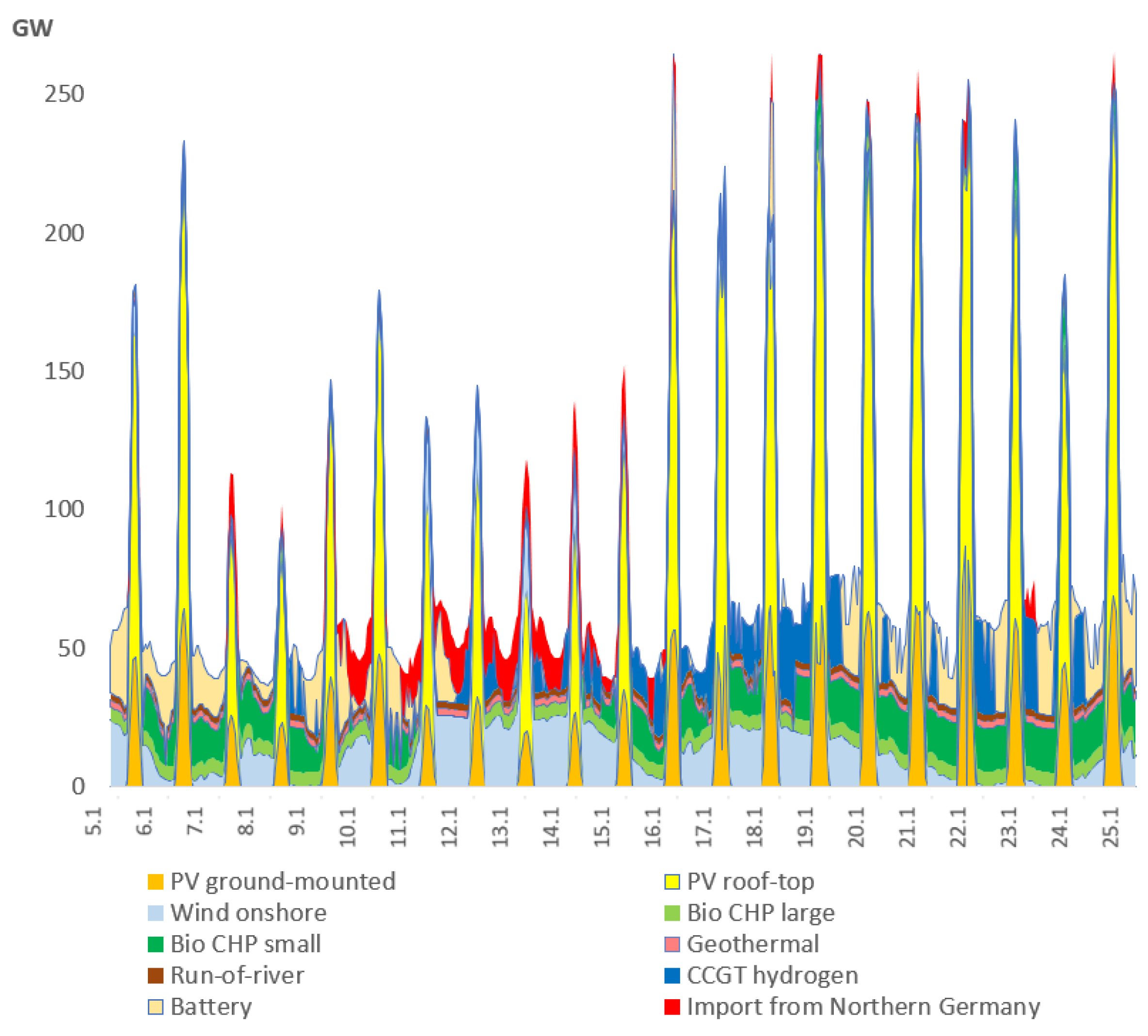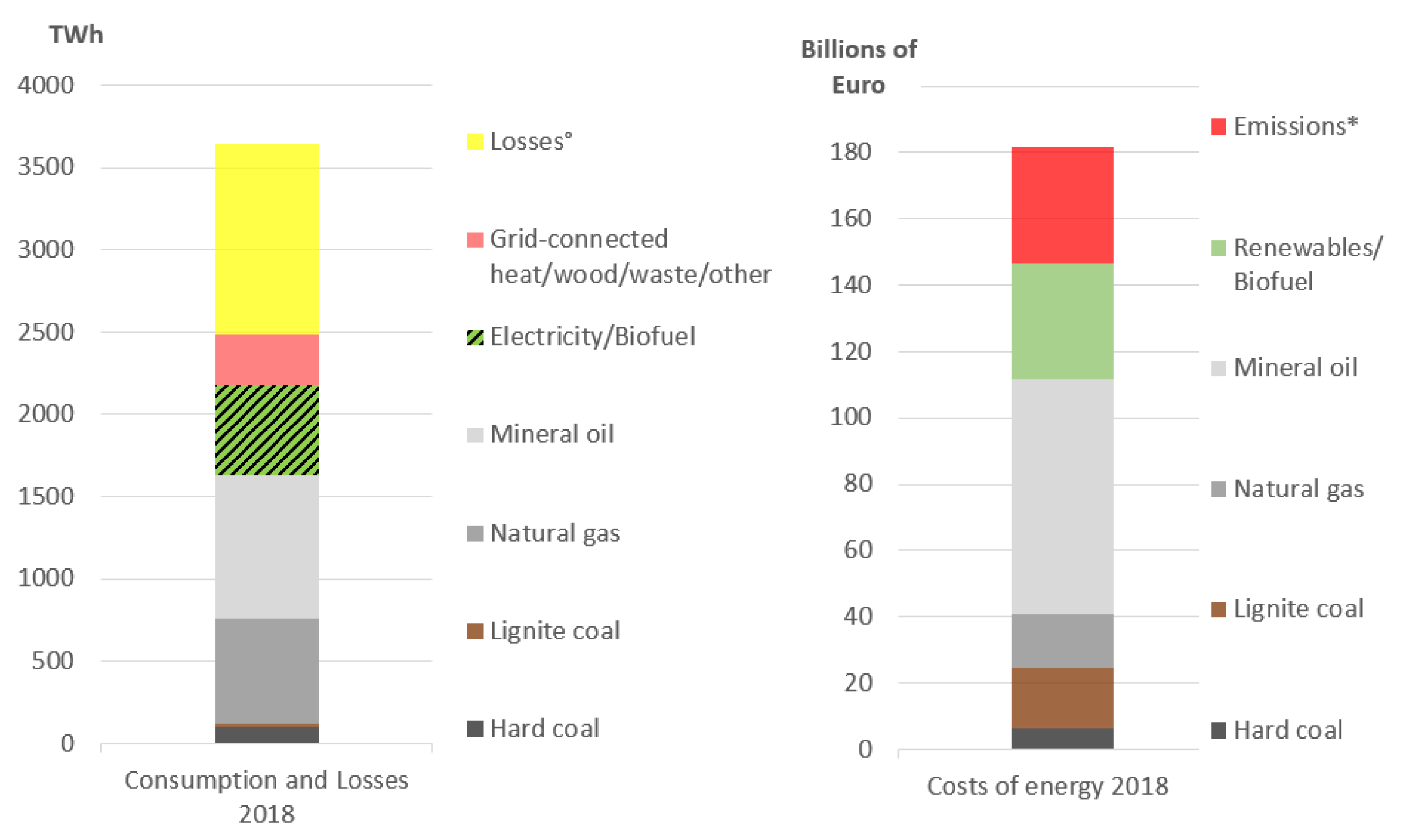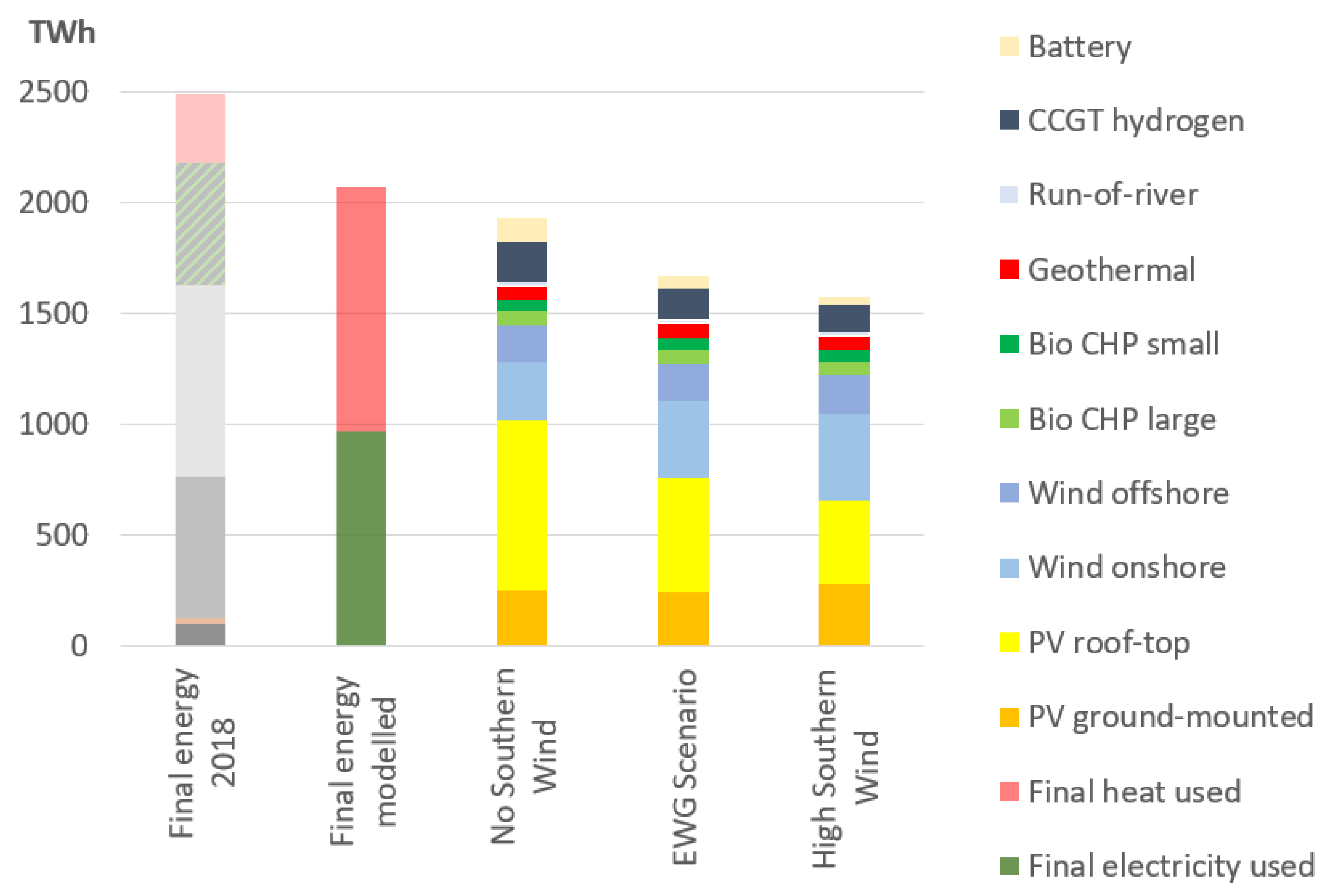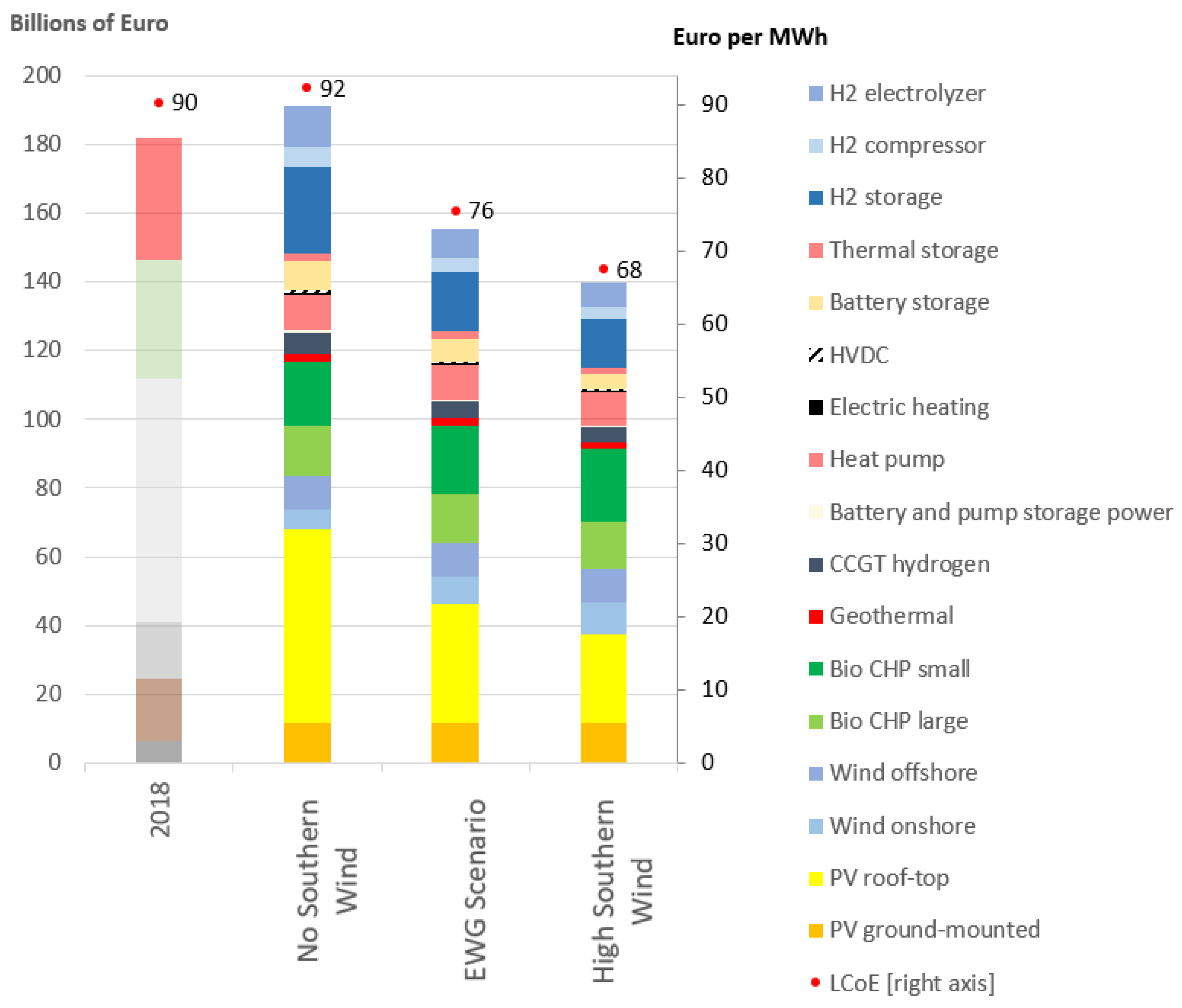An Economically Viable 100% Renewable Energy System for All Energy Sectors of Germany in 2030
Abstract
:1. Introduction
2. Model
3. Data for Germany
3.1. Current Situation in Germany—Energy Demand and Costs
3.2. Foundations for a 100% RE System in 2030
3.2.1. Existing Transmission Capacity
3.2.2. Existing Capacities and Expansion Potential of RE Sources until 2030
3.2.3. Consumption and Generation Profiles in Northern and Southern Germany
4. Results
4.1. Capacities for an Emission Free Energy System
4.2. Cross-Sectoral Electricity Generation for Full Climate Protection in Germany
4.3. Heat Supply: Coupled, Stored, or All-Electric
4.4. Energy Storage for the Energy Transition
4.5. Costs of EUR 76 per MWh Possible in 100% RE System
4.6. Required Capacity Expansion in Germany for Zero Emissions in 2030
4.7. Necessary Expansion of the High-Voltage Grid
5. Limitations
6. Conclusions
Author Contributions
Funding
Institutional Review Board Statement
Informed Consent Statement
Acknowledgments
Conflicts of Interest
Abbreviations
| Total levelized cost of energy | |
| Capital renumeration factor | |
| Fixed costs of technologies denoted n | |
| Installed capacity | |
| Variable costs of energy provision of technologies denoted n | |
| Frequency of simulated time step t | |
| q | Generation quantity |
| Fuel prices of technologies denoted n | |
| Degrees of efficiency of technologies denoted n | |
| Operating costs of technologies denoted n | |
| Electricity generation in all electricity technologies L | |
| Battery charging current | |
| Hydrolysis current | |
| Heat pump electricity | |
| Net exports to other regions | |
| Classical electricity consumption in every time step t and every region r | |
| Region, i.e., northern Germany or southern Germany | |
| Transport technology | |
| Heat generation in heat technologies M | |
| Heat index | |
| Heat index of CHP plants | |
| Heat storage demand | |
| Heat consumption | |
| K | New installed capacity |
| Existing capacity | |
| Total installed capacity | |
| Unavailability | |
| Energy generation | |
| Charging level of storage technology in time step t | |
| Charging level of storage technology in time step T | |
| Charging energy | |
| Discharging energy |
Appendix A. Technical and Economic Assumptions
| CAPEX (EUR/kW) | OPEX Fix (EUR/kW*a) | OPEX var (EUR/kW*h) | CRF (n) | ||||
|---|---|---|---|---|---|---|---|
| PV ground-mounted | 320 | 13.20 | – | 0.07 | 1.00 | 1.00 | 1.00 |
| PV rooftop | 720 | 17.60 | – | 0.07 | 1.00 | 1.00 | 1.00 |
| Wind onshore | 1100 | 21.00 | – | 0.07 | 1.00 | 1.00 | 1.00 |
| Wind offshore | 2580 | 83.70 | – | 0.07 | 1.00 | 1.00 | 1.00 |
| Bioenergy CHP large | 429 | 17.20 | 0.08 | 0.07 | 1.00 | 0.35 | 1.00 |
| Bioenergy CHP small | 2500 | 17.20 | 0.08 | 0.07 | 1.00 | 0.30 | 1.00 |
| Battery storage | 100 | 9.00 | – | 0.08 | 0.98 | 0.98 | 1.00 |
| Battery and pumped storage power | 100 | – | – | 0.08 | 1.00 | 1.00 | 1.00 |
| Run-of-river hydro | – | – | – | 0.05 | 1.00 | 1.00 | 1.00 |
| Heat pump | 750 | 15.60 | – | 0.07 | 3.57 | 3.57 | 1.00 |
| Heat storage | 30 | 0.60 | – | 0.06 | 0.95 | 0.95 | 0.95 |
| Hydrogen storage | 14 | – | – | 0.07 | 0.99 | 0.99 | 0.98 |
| Hydrogen compressor | 256 | 0.86 | – | 0.10 | 0.98 | 1.00 | 1.00 |
| Hydrogen electrolyzer | 500 | 1.11 | 0.00 | 0.07 | 0.60 | 0.99 | 0.99 |
| Gas and steam power plant with hydrogen combustion | 975 | – | 0.00 | 0.06 | 1.00 | 0.60 | 1.00 |
| Geothermal | 4470 | – | – | 0.06 | 1.00 | 1.00 | 1.00 |
| HVDC (per 500 km) | 984 | 1.50 | – | 0.05 | 0.99 | 0.99 | 1.00 |
| Electric heating | 200 | – | – | 0.05 | 1.00 | 1.00 | 1.00 |
Appendix B. Results for Northern and Southern Germany


References
- Hansen, K.; Breyer, C.; Lund, H. Status and perspectives on 100% renewable energy systems. Energy 2019, 175, 471–480. [Google Scholar] [CrossRef]
- Palzer, A.; Henning, H.M. A comprehensive model for the German electricity and heat sector in a future energy system with a dominant contribution from renewable energy technologies—Part II: Results. Renew. Sustain. Energy Rev. 2014, 30, 1019–1034. [Google Scholar] [CrossRef]
- Lunz, B.; Stöcker, P.; Eckstein, S.; Nebel, A.; Samadi, S.; Erlach, B.; Fischedick, M.; Elsner, P.; Sauer, D.U. Scenario-based comparative assessment of potential future electricity systems–A new methodological approach using Germany in 2050 as an example. Appl. Energy 2016, 171, 555–580. [Google Scholar] [CrossRef] [Green Version]
- Prina, M.G.; Manzolini, G.; Moser, D.; Nastasi, B.; Sparber, W. Classification and challenges of bottom-up energy system models—A review. Renew. Sustain. Energy Rev. 2020, 129, 109917. [Google Scholar] [CrossRef]
- Lyden, A.; Pepper, R.; Tuohy, P.G. A modelling tool selection process for planning of community scale energy systems including storage and demand side management. Sustain. Cities Soc. 2018, 39, 674–688. [Google Scholar] [CrossRef]
- Xu, Y.; Yan, C.; Liu, H.; Wang, J.; Yang, Z.; Jiang, Y. Smart energy systems: A critical review on design and operation optimization. Sustain. Cities Soc. 2020, 62, 102369. [Google Scholar] [CrossRef]
- Fridgen, G.; Keller, R.; Körner, M.F.; Schöpf, M. A holistic view on sector coupling. Energy Policy 2020, 147, 111913. [Google Scholar] [CrossRef]
- Kiss, V.M. Modelling the energy system of Pécs–The first step towards a sustainable city. Energy 2015, 80, 373–387. [Google Scholar] [CrossRef]
- Dominković, D.; Bačeković, I.; Sveinbjörnsson, D.; Pedersen, A.; Krajačić, G. On the way towards smart energy supply in cities: The impact of interconnecting geographically distributed district heating grids on the energy system. Energy 2017, 137, 941–960. [Google Scholar] [CrossRef] [Green Version]
- Sveinbjörnsson, D.; Amer-Allam, S.B.; Hansen, A.B.; Algren, L.; Pedersen, A.S. Energy supply modelling of a low-CO2 emitting energy system: Case study of a Danish municipality. Appl. Energy 2017, 195, 922–941. [Google Scholar] [CrossRef] [Green Version]
- Barragán-Escandón, E.A.; Zalamea-León, E.F.; Terrados-Cepeda, J.; Vanegas-Peralta, P. Energy self-supply estimation in intermediate cities. Renew. Sustain. Energy Rev. 2020, 129, 109913. [Google Scholar] [CrossRef]
- Sola, A.; Corchero, C.; Salom, J.; Sanmarti, M. Multi-domain urban-scale energy modelling tools: A review. Sustain. Cities Soc. 2020, 54, 101872. [Google Scholar] [CrossRef]
- Jacobson, M.Z.; Delucchi, M.A. Providing all global energy with wind, water, and solar power, Part I: Technologies, energy resources, quantities and areas of infrastructure, and materials. Energy Policy 2011, 39, 1154–1169. [Google Scholar] [CrossRef]
- Delucchi, M.A.; Jacobson, M.Z. Providing all global energy with wind, water, and solar power, Part II: Reliability, system and transmission costs, and policies. Energy Policy 2011, 39, 1170–1190. [Google Scholar] [CrossRef]
- Jacobson, M.Z.; Delucchi, M.A.; Bauer, Z.A.F.; Goodman, S.C.; Chapman, W.E.; Cameron, M.A.; Bozonnat, C.; Chobadi, L.; Clonts, H.A.; Enevoldsen, P.; et al. 100% clean and renewable wind, water, and sunlight all-sector energy roadmaps for 139 countries of the world. Joule 2017, 1, 108–121. [Google Scholar] [CrossRef] [Green Version]
- Child, M.; Koskinen, O.; Linnanen, L.; Breyer, C. Sustainability guardrails for energy scenarios of the global energy transition. Renew. Sustain. Energy Rev. 2018, 91, 321–334. [Google Scholar] [CrossRef]
- Connolly, D.; Lund, H.; Mathiesen, B. Smart Energy Europe: The technical and economic impact of one potential 100% renewable energy scenario for the European Union. Renew. Sustain. Energy Rev. 2016, 60, 1634–1653. [Google Scholar] [CrossRef]
- Brown, T.; Schlachtberger, D.; Kies, A.; Schramm, S.; Greiner, M. Synergies of sector coupling and transmission reinforcement in a cost-optimised, highly renewable European energy system. Energy 2018, 160, 720–739. [Google Scholar] [CrossRef] [Green Version]
- Zappa, W.; Junginger, M.; van den Broek, M. Is a 100% renewable European power system feasible by 2050? Appl. Energy 2019, 233, 1027–1050. [Google Scholar] [CrossRef]
- Tröndle, T.; Lilliestam, J.; Marelli, S.; Pfenninger, S. Trade-offs between geographic scale, cost, and infrastructure requirements for fully renewable electricity in Europe. Joule 2020, 4, 1929–1948. [Google Scholar] [CrossRef] [PubMed]
- Lund, H.; Mathiesen, B.V. Energy system analysis of 100% renewable energy systems—The case of Denmark in years 2030 and 2050. Energy 2009, 34, 524–531. [Google Scholar] [CrossRef]
- Mathiesen, B.V.; Lund, H.; Karlsson, K. 100% Renewable energy systems, climate mitigation and economic growth. Appl. Energy 2011, 88, 488–501. [Google Scholar] [CrossRef]
- Connolly, D.; Mathiesen, B.V. A technical and economic analysis of one potential pathway to a 100% renewable energy system. Int. J. Sustain. Energy Plan. Manag. 2014, 1, 7–28. [Google Scholar]
- Yue, X.; Patankar, N.; Decarolis, J.; Chiodi, A.; Rogan, F.; Deane, J.; O’Gallachoir, B. Least cost energy system pathways towards 100% renewable energy in Ireland by 2050. Energy 2020, 207, 118264. [Google Scholar] [CrossRef]
- Child, M.; Ilonen, R.; Vavilov, M.; Kolehmainen, M.; Breyer, C. Scenarios for sustainable energy in Scotland. Wind Energy 2019, 22, 666–684. [Google Scholar] [CrossRef]
- Bellocchi, S.; Manno, M.; Noussan, M.; Prina, M.G.; Vellini, M. Electrification of transport and residential heating sectors in support of renewable penetration: Scenarios for the Italian energy system. Energy 2020, 196, 117062. [Google Scholar] [CrossRef]
- Child, M.; Breyer, C. Vision and initial feasibility analysis of a recarbonised Finnish energy system for 2050. Renew. Sustain. Energy Rev. 2016, 66, 517–536. [Google Scholar] [CrossRef]
- Gils, H.C.; Pregger, T.; Flachsbarth, F.; Jentsch, M.; Dierstein, C. Comparison of spatially and temporally resolved energy system models with a focus on Germany’s future power supply. Appl. Energy 2019, 255, 113889. [Google Scholar] [CrossRef]
- Hansen, K.; Mathiesen, B.V.; Skov, I.R. Full energy system transition towards 100% renewable energy in Germany in 2050. Renew. Sustain. Energy Rev. 2019, 102, 1–13. [Google Scholar] [CrossRef]
- Bogdanov, D.; Gulagi, A.; Fasihi, M.; Breyer, C. Full energy sector transition towards 100% renewable energy supply: Integrating power, heat, transport and industry sectors including desalination. Appl. Energy 2021, 283, 116273. [Google Scholar] [CrossRef]
- Bundesministerium für Wirtschaft und Energie, BMWI. Gesamtausgabe der Energiedaten–Datensammlung des BMWI. 2021. Available online: https://www.bmwi.de/Redaktion/DE/Binaer/Energiedaten/energiedaten-gesamt-xls.xlsx?_blob=publicationFile&v=133 (accessed on 20 August 2021).
- Nahmacher, P.; Paris, C.; Ruge, M.; Spieker, S.; Anderski, T.; Bohlen, S.; Kaiser, R.; Podewski, C.; Apfelbeck, J.; Kahl, T.; et al. Szenariorahmen zum Netzentwicklungsplan Strom 2035. 2020. Available online: https://www.netzentwicklungsplan.de/de/netzentwicklungsplaene/netzentwicklungsplan-2035-2021 (accessed on 20 August 2021).
- Fath, K. Technical and Economic Potential for Photovoltaic Systems on Buildings; KIT Scientific Publishing: Karlsruhe, Germany, 2018. [Google Scholar] [CrossRef]
- Koivisto, M.; Plakas, K.; Hurtado Ellmann, E.R.; Davis, N.; Sørensen, P. Application of microscale wind and detailed wind power plant data in large-scale wind generation simulations. Electr. Power Syst. Res. 2021, 190, 106638. [Google Scholar] [CrossRef]
- Fraunholz, C.; Hladik, D.; Keles, D.; Möst, D.; Fichtner, W. On the long-term efficiency of market splitting in Germany. Energy Policy 2021, 149, 111833. [Google Scholar] [CrossRef]
- Skamarock, W.C.; Klemp, J.B.; Dudhia, J.; Gill, D.O.; Barker, D.M.; Wang, W.; Powers, J.G. A Description of the Advanced Research WRF Version University Corporation for Atmospheric Research, doi:10.5065/D6DZ069T. Technical Report. National Center For Atmospheric Research Boulder Co Mesoscale and Microscale, 2005. Available online: https://opensky.ucar.edu/islandora/object/technotes:479 (accessed on 20 August 2021).
- Bogdanov, D.; Ram, M.; Aghahosseini, A.; Gulagi, A.; Oyewo, A.S.; Child, M.; Caldera, U.; Sadovskaia, K.; Farfan, J.; De Souza Noel Simas Barbosa, L.; et al. Low-cost renewable electricity as the key driver of the global energy transition towards sustainability. Energy 2021, 227, 120467. [Google Scholar] [CrossRef]
- Ram, M.; Bogdonov, D.; Aghahosseini, A.; Gulagi, A.; Oyewo, S.A.; Child, M.; Caldera, U.; Sadovskaia, K.; Farfan, J.; Barbosa, L.S.; et al. Global Energy System based on 100% Renewable Energy Energy Transition in Europe Across Power, Heat, Transport and Desalination Sectors; Lappeenranta University of Technology: Lappeenranta, Finland, 2018. [Google Scholar]









| North | South | |||
|---|---|---|---|---|
| 2020 | Potential | 2020 | Potential | |
| PV ground-mounted | 8.4 | 221.2 | 4.7 | 128.8 |
| PV rooftop | 14.9 | >600 | 19.1 | >600 |
| Wind onshore | 44.6 | 73.3 | 10.7 | 36.7 |
| Wind offshore | 6.8 | 40.0 | - | - |
| Bioenergy CHP large* | - | 10.0 | 1.0 | 5.0 |
| Bioenergy CHP small* | 3.2 | energy limit | 3.8 | energy limit |
| Geothermal | - | 5.3 | 1.0 | 2.7 |
| Run-of-river hydro | 0.3 | 0.3 | 2.3 | 2.3 |
| Pumped-storage hydro | 2.5 | 2.5 | 4.0 | 4.0 |
Publisher’s Note: MDPI stays neutral with regard to jurisdictional claims in published maps and institutional affiliations. |
© 2021 by the authors. Licensee MDPI, Basel, Switzerland. This article is an open access article distributed under the terms and conditions of the Creative Commons Attribution (CC BY) license (https://creativecommons.org/licenses/by/4.0/).
Share and Cite
Traber, T.; Hegner, F.S.; Fell, H.-J. An Economically Viable 100% Renewable Energy System for All Energy Sectors of Germany in 2030. Energies 2021, 14, 5230. https://doi.org/10.3390/en14175230
Traber T, Hegner FS, Fell H-J. An Economically Viable 100% Renewable Energy System for All Energy Sectors of Germany in 2030. Energies. 2021; 14(17):5230. https://doi.org/10.3390/en14175230
Chicago/Turabian StyleTraber, Thure, Franziska Simone Hegner, and Hans-Josef Fell. 2021. "An Economically Viable 100% Renewable Energy System for All Energy Sectors of Germany in 2030" Energies 14, no. 17: 5230. https://doi.org/10.3390/en14175230
APA StyleTraber, T., Hegner, F. S., & Fell, H.-J. (2021). An Economically Viable 100% Renewable Energy System for All Energy Sectors of Germany in 2030. Energies, 14(17), 5230. https://doi.org/10.3390/en14175230







